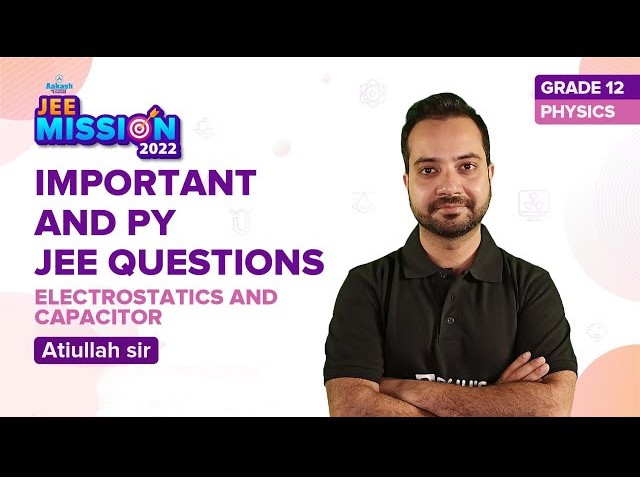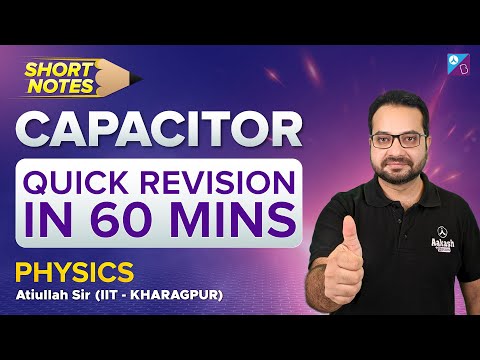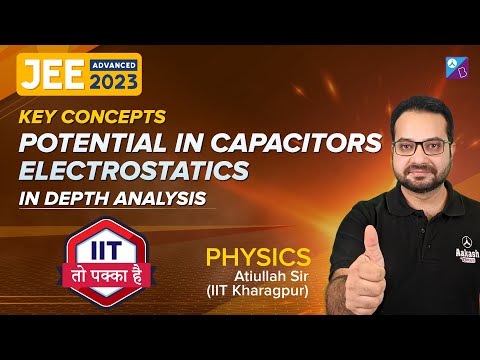A capacitor is a little like a battery but works completely differently. A battery is an electronic device that converts chemical energy into electrical energy, whereas a capacitor is an electronic component that stores electrostatic energy in an electric field. In this article, let’s learn about capacitors in detail.
|
Table of Contents |
What Is a Capacitor?
A capacitor is a two-terminal electrical device that can store energy in the form of an electric charge. It consists of two electrical conductors that are separated by a distance. The space between the conductors may be filled by vacuum or with an insulating material known as a dielectric. The ability of the capacitor to store charges is known as capacitance.
Capacitors store energy by holding apart pairs of opposite charges. The simplest design for a capacitor is a parallel plate, which consists of two metal plates with a gap between them. But, different types of capacitors are manufactured in many forms, styles, lengths, girths, and materials.
How Does a Capacitor Work?
For demonstration, let us consider the most basic structure of a capacitor – the parallel plate capacitor. It consists of two parallel plates separated by a dielectric. When we connect a DC voltage source across the capacitor, one plate is connected to the positive end (plate I) and the other to the negative end (plate II). When the potential of the battery is applied across the capacitor, plate I become positive with respect to plate II. The current tries to flow through the capacitor at the steady-state condition from its positive plate to its negative plate. But it cannot flow due to the separation of the plates with an insulating material.

An electric field appears across the capacitor. The positive plate (plate I) accumulates positive charges from the battery, and the negative plate (plate II) accumulates negative charges from the battery. After a point, the capacitor holds the maximum amount of charge as per its capacitance with respect to this voltage. This time span is called the charging time of the capacitor.
When the battery is removed from the capacitor, the two plates hold a negative and positive charge for a certain time. Thus, the capacitor acts as a source of electrical energy.

If these plates are connected to a load, the current flows to the load from Plate I to Plate II until all the charges are dissipated from both plates. This time span is known as the discharging time of the capacitor.

How Do You Determine the Value of Capacitance?

The conducting plates have some charges Q1 and Q2 (Usually, if one plate has +q, the other has –q charge). The electric field in the region between the plates depends on the charge given to the conducting plates. We also know that potential difference (V) is directly proportional to the electric field hence we can say,
This constant of proportionality is known as the capacitance of the capacitor.
Capacitance is the ratio of the change in the electric charge of a system to the corresponding change in its electric potential.
The capacitance of any capacitor can be either fixed or variable, depending on its usage. From the equation, it may seem that ‘C’ depends on charge and voltage. Actually, it depends on the shape and size of the capacitor and also on the insulator used between the conducting plates.
Recommended Videos
Capacitance Important Topics for JEE

Electrostatics and Capacitance Important Topics for JEE

Read More: Difference between a Capacitor and a Battery
Energy Stored in a Capacitor
Once the opposite charges have been placed on either side of a parallel-plate capacitor, the charges can be used to work by allowing them to move towards each other through a circuit. The equation gives the total energy that can be extracted from a fully charged capacitor:
Capacitors function a lot like rechargeable batteries. The main difference between a capacitor and a battery lies in the technique they employ to store energy. Unlike batteries, the capacitor’s ability to store energy doesn’t come from chemical reactions but from the physical design that allows it to hold negative and positive charges apart.
Read More: Energy Stored in a Capacitor
Standard Units of Capacitance
The basic unit of capacitance is Farad. But, Farad is a large unit for practical tasks. Hence, capacitance is usually measured in the sub-units of Farads, such as micro-farads (µF) or pico-farads (pF).
Most of the electrical and electronic applications are covered by the following standard unit (SI) prefixes for easy calculations:
- 1 mF (millifarad) = 10−3 F
- 1 μF (microfarad) =10−6 F
- 1 nF (nanofarad) = 10−9 F
- 1 pF (picofarad) = 10−12 F
Capacitance of a Parallel Plate Capacitor

The parallel plate capacitor as shown in the figure has two identical conducting plates, each having a surface area A and separated by a distance d. When voltage V is applied to the plates, it stores charge Q.
The force between charges increases with charge values and decreases with the distance between them. The bigger the area of the plates, the more charge they can store. Hence, the value of C is greater for a large value of A. Similarly, the closer the plates are, the greater the attraction of the opposite charges on them. Therefore C is greater for a smaller d.
The formula gives the charge density on the plates
When the distance of separation (d) is small, the electric field between the plates is fairly uniform, and its magnitude is given by:
As the electric field between the plates is uniform, the potential difference between the plates is given by
Substituting the above value of V in the capacitance formula, we get
| The capacitance of a parallel plate capacitor is given by the formula \(\begin{array}{l}C=\epsilon _{0}\frac{A}{d}\end{array} \) |
Read More: Parallel Plate Capacitor
Solved Example:
Calculate the capacitance of an empty parallel-plate capacitor with metal plates with an area of 1.00 m2, separated by 1.00 mm.
Solution:
Using the formula, we can calculate the capacitance as follows:
Substituting the values, we get
Capacitance of a Spherical Capacitor
Spherical capacitors consist of two concentric conducting spherical shells of radii R1 and R2. The shells are given equal and opposite charges +Q and –Q respectively. The electric field between shells is directed radially outward. The magnitude of the field can be obtained by applying Gauss law over a spherical Gaussian surface of radius r concentric with the shells.

The enclosed charge is +Q, therefore
The electric field between the conductor is given as
Integrating E along the radial path between the shells, we get
The potential difference between two conductors can be calculated using the formula
The potential difference between the plates is
Substituting the value of V in the capacitance formula, we get
| The capacitance of a spherical capacitor is given by the equation \(\begin{array}{l}C=4\pi \epsilon _0\frac{R_1R_2}{R_2-R_1}\end{array} \) |
Read More: Capacitors
The video is a rapid revision of electric charges and capacitor for JEE MAIN, presented by Atiullah Sir through short notes.

Solved Example:
A spherical capacitor has an inner sphere of radius 12 cm and an outer sphere of radius 13 cm. The outer sphere is earthed and the inner sphere is given a charge of 2.5 µC. The space between the concentric spheres is filled with a liquid of dielectric constant 32. Determine the capacitance of the capacitor.
Solution:
Given:
The radius of the inner sphere, R2 = 12 cm = 0.12 m
The radius of the outer sphere, R1= 13 cm = 0.13 m
Charge on the inner sphere, q = 2.5 μC = 2.5 x 10-6 C
Dielectric constant of a liquid, ∈r = 32
The capacitance of a spherical capacitor is given by the relation:
∈0 = Permittivity of free space = 8.85 x 10-12 C2 N-1 m-2
Substituting the values in the equation, we get
Factors Affecting Capacitance
Dielectric
The effect of dielectric on capacitance is that the greater the permittivity of the dielectric, the greater the capacitance, likewise lesser the permittivity of the dielectric the lesser is the capacitance. Some materials offer less opposition to the field flux for a given amount of field force. Materials with greater permittivity allow more field flux. Hence greater charge is collected.
Plate Spacing
The effect of spacing on the capacitance is that it is inversely proportional to the distance between the plates. Mathematically it is given as:
Area of the Plates
The effect of the area of the plate is that the capacitance is directly proportional to the area. The larger the plate area, the more the capacitance value. Mathematically it is given as:
Read More: Effect of Dielectric on Capacitance
What Are the Applications of Capacitors?
Capacitors for Energy Storage
Since the late 18th century, capacitors have been used to store electrical energy. Individual capacitors do not hold much energy, providing only enough power for electronic devices during temporary power outages or when they need additional power. Many applications use capacitors as energy sources, and a few of them are as follows:
- Audio equipment
- Camera Flashes
- Power supplies
- Magnetic coils
- Lasers
Supercapacitors are capacitors that have high capacitances up to 2 kF. These capacitors store large amounts of energy and offer new technological possibilities in areas such as electric cars, regenerative braking in the automotive industry and industrial electrical motors, computer memory backup during power loss, and many others.
Capacitors for Power Conditioning
One of the important applications of capacitors is the conditioning of power supplies. Capacitors allow only AC signals to pass when they are charged, blocking DC signals. This capacitor effect is used in separating or decoupling different parts of electrical circuits to reduce noise as a result of improving efficiency. Capacitors are also used in utility substations to counteract inductive loading introduced by transmission lines.
Capacitors as Sensors
Capacitors are used as sensors to measure a variety of things including humidity, mechanical strain, and fuel levels. Two aspects of capacitor construction are used in the sensing application – the distance between the parallel plates and the material between them. The former detects mechanical changes such as acceleration and pressure, and the latter is used in sensing air humidity.
Capacitors for Signal Processing
There are advanced applications of capacitors in information technology. Capacitors are used by Dynamic Random Access Memory (DRAM) devices to represent binary information as bits. Capacitors are also used in conjunction with inductors to tune circuits to particular frequencies, an effect exploited by radio receivers, speakers, and analog equalizers.
Watch the video and learn more about potential in capacitors

Frequently Asked Questions on Capacitors and Capacitance
What is a variable capacitor?
How does the shape of the capacitor affect its capacitance?
- The distance between the plates
The more distant the plates are, the less the free electrons on the far plate feel the push of the electrons that are being added to the negative plate. This makes it harder to add more negative charges to the negative plate. The current will flow through a short circuit if the plates are closer. This implies that the capacitance of a parallel plate is inversely related to the plate separation.
- Area of the plates
It’s easier to add charges to a capacitor if the parallel plates have a huge area. Two wide metal plates would give two repelling-like charges a greater range to spread out across the plate, making it easier to add a lot more negative charges to one plate. Likewise, a very small plate area would cause the electrons to get cramped together earlier, making it harder to get a large difference in charge for a given voltage.
What are Ultracapacitors?
How long does a capacitor last?
What kind of energy is stored in a capacitor?
Why isn’t water used as a dielectric in a capacitor?
Stay tuned with BYJU’S for more such interesting articles. Also, register to “BYJU’S – The Learning App” for loads of interactive, engaging Physics-related videos and unlimited academic assistance.

Comments